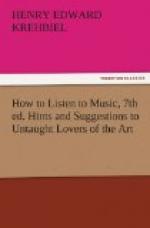[Sidenote: Concertos.]
[Sidenote: Chamber music.]
Concertos for pianoforte or violin are usually written in three movements, of which the first and last follow the symphonic model in respect of elaboration and form, and the second is a brief movement in slow or moderate time, which has the character of an intermezzo. As to the nomenclature of chamber music, it is to be noted that unless connected with a qualifying word or phrase, “Quartet” means a string quartet. When a pianoforte is consorted with strings the work is spoken of as a Pianoforte Trio, Quartet, or Quintet, as the case may be.
[Sidenote: The Overture.]
[Sidenote: Pot-pourris.]
The form of the overture is that of the first movement of the sonata, or symphony, omitting the repetition of the first subdivision. Since the original purpose, which gave the overture its name (Ouverture = aperture, opening), was to introduce a drama, either spoken or lyrical, an oratorio, or other choral composition, it became customary for the composers to choose the subjects of the piece from the climacteric moments of the music used in the drama. When done without regard to the rules of construction (as is the case with practically all operetta overtures and Rossini’s) the result is not an overture at all, but a pot-pourri, a hotch-potch of jingles. The present beautiful form, in which Beethoven and other composers have shown that it is possible to epitomize an entire drama, took the place of an arbitrary scheme which was wholly aimless, so far as the compositions to which they were attached were concerned.
[Sidenote: Old styles of overtures.]
[Sidenote: The Prelude.]
[Sidenote: Gluck’s principle.]
[Sidenote: Descriptive titles.]
The earliest fixed form of the overture is preserved to the current lists of to-day by the compositions of Bach and Handel. It is that established by Lully, and is tripartite in form, consisting of a rapid movement, generally a fugue, preceded and followed by a slow movement which is grave and stately in its tread. In its latest phase the overture has yielded up its name in favor of Prelude (German, Vorspiel), Introduction, or Symphonic Prologue. The finest of these, without borrowing their themes from the works which they introduce, but using new matter entirely, seek to fulfil the aim which Gluck set for himself, when, in the preface to “Alceste,” he wrote: “I imagined that the overture ought to prepare the audience for the action of the piece, and serve as a kind of argument to it.” Concert overtures are compositions designed by the composers to stand as independent pieces instead of for performance in connection with a drama, opera, or oratorio. When, as is frequently the case, the composer, nevertheless, gives them a descriptive title ("Hebrides,” “Sakuntala"),




